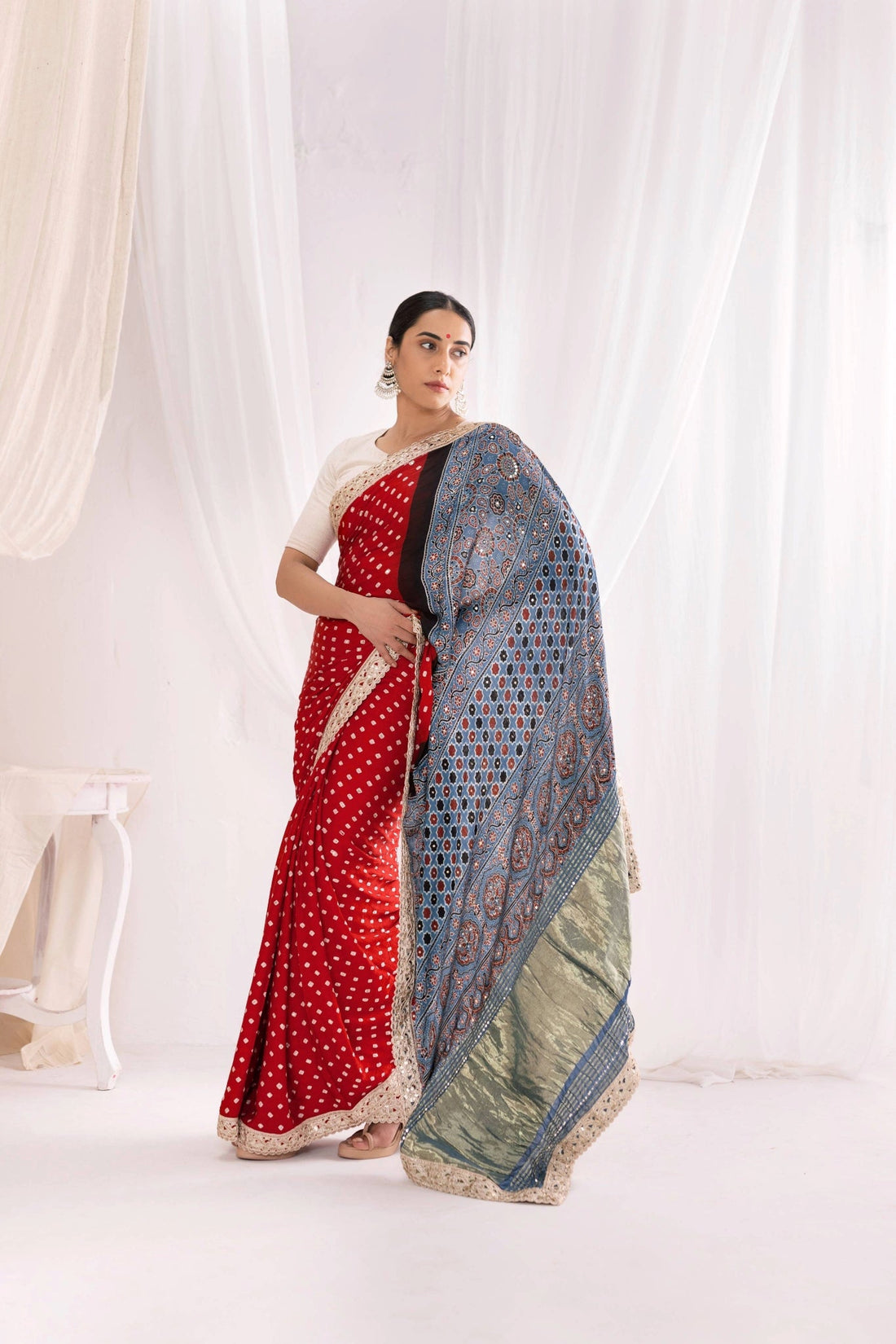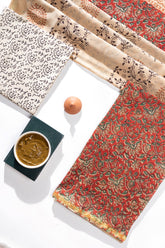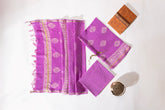Table of Contents
-
Understanding Ajrakh: A Timeless Textile Art
-
The Resurgence of Ajrakh in Contemporary Fashion
-
Modal Silk: The Perfect Canvas for Modern Ajrakh
-
Designer Approaches to Reinventing Ajrakh
-
Ajrakh in Saree Design: Blending Heritage and Modernity
-
Beyond Sarees: Ajrakh in Fusion and Western Wear
-
Color Palette Innovations in Modern Ajrakh
-
Sustainability and Ethical Considerations
-
Styling Modern Ajrakh Pieces
-
The Future of Ajrakh in Fashion
-
Frequently Asked Questions
The ancient art of Ajrakh block printing, with its intricate geometric patterns and deep, earthy hues, is experiencing a remarkable renaissance in the world of modern fashion. Designers are increasingly drawn to this traditional craft, not just for its rich heritage, but for its versatility and sustainable qualities. From stunning Ajrakh modal silk sarees that offer a luxurious drape to innovative fusion wear, Ajrakh is being reimagined for the contemporary wardrobe. At VastraRaag, we celebrate this fusion of tradition and innovation, showcasing how designers are breathing new life into this timeless textile art.
Understanding Ajrakh: A Timeless Textile Art
Ajrakh is a unique form of block printing that originated in the regions of Sindh (present-day Pakistan), Kutch in Gujarat, and Rajasthan in India. The name "Ajrakh" is believed to be derived from "Azrak," the Arabic word for blue, a dominant color in this craft. This intricate process involves multiple stages of printing and washing the fabric using natural dyes and mordants like indigo, madder, harda, lime, and alizarin. Traditionally, Ajrakh fabrics were printed on both sides with perfectly aligned patterns, a testament to the incredible skill of the artisans. These textiles were originally worn by cattle herders and local communities, serving both functional and cultural purposes.
The complex geometric and floral patterns are created using hand-carved wooden blocks. Each piece of Ajrakh fabric is a labor of love, reflecting centuries of tradition and a deep connection to nature.
The Resurgence of Ajrakh in Contemporary Fashion
In recent years, Ajrakh has captured the imagination of designers and fashion enthusiasts alike, leading to its significant revival. This resurgence is driven by several factors:
-
A growing appreciation for handcrafted and artisanal products
-
Increased consumer interest in sustainable and eco-friendly fashion, as Ajrakh traditionally uses natural dyes
-
The versatility of Ajrakh patterns, which can be adapted to both traditional and modern silhouettes
-
The rise of online platforms that provide global access to traditional crafts, allowing artisans and designers to reach a wider audience
Designers are not merely replicating old patterns; they are actively innovating, exploring new color combinations, fabrics, and garment styles, ensuring that Ajrakh remains relevant and exciting for today's fashion-conscious consumers.
Modal Silk: The Perfect Canvas for Modern Ajrakh
One of the key innovations in modern Ajrakh fashion is the use of new fabric bases, with modal silk emerging as a popular choice. Modal silk, a bio-fabric made from beechwood pulp, offers a luxurious, smooth texture and a beautiful drape that complements the richness of Ajrakh prints.
Benefits of Modal Silk for Ajrakh:
-
Softness and Comfort: Modal silk is known for its exceptional softness, making Ajrakh modal silk sarees and garments incredibly comfortable to wear
-
Luxurious Drape: The fabric has a fluid drape that enhances the elegance of sarees and other flowing garments
-
Vibrant Prints: Modal silk holds natural dyes well, allowing the intricate Ajrakh patterns to appear vibrant and rich
-
Sustainability: As a plant-based fiber, modal offers a more sustainable alternative to some traditional silks, aligning with the eco-conscious ethos of Ajrakh
-
Versatility: It is suitable for various garments, from sarees and kurtas to contemporary Western wear
The combination of traditional Ajrakh printing with the modern appeal of modal silk has created a new category of luxurious and comfortable ethnic wear, as seen in collections like the Ajrakh Hand Block Printed Modal Silk Sarees.
Designer Approaches to Reinventing Ajrakh
Contemporary designers are adopting various strategies to reinvent Ajrakh for modern sensibilities:
-
New Silhouettes: While Ajrakh sarees remain popular, designers are incorporating Ajrakh prints into a wide range of modern garments, including jackets, dresses, skirts, pants, co-ord sets, and even blazers and pantsuits
-
Fusion Wear: A significant trend is the blending of Ajrakh with Western silhouettes to create fusion wear. An Ajrakh dupatta might be paired with a little black dress, or an Ajrakh jacket worn over jeans and a t-shirt
-
Pattern Play: Designers are experimenting with the scale and placement of traditional Ajrakh motifs, sometimes using them as accents or combining them with other textile arts like Bandhej or Ikat
-
Collaborations with Artisans: Many designers collaborate directly with Ajrakh artisans, fostering a co-creative process that respects traditional techniques while introducing new design ideas. This ensures the craft's authenticity while promoting innovation
-
Upcycling and Restyling: The durability and timeless appeal of Ajrakh make it suitable for upcycling and creating versatile pieces that can be restyled in multiple ways
Ajrakh in Saree Design: Blending Heritage and Modernity
The saree remains a central canvas for Ajrakh's modern interpretations. Designers are creating Ajrakh modal silk sarees that appeal to a contemporary aesthetic while honoring the craft's roots.
Innovations in Ajrakh Sarees:
-
Fabric Blends: Beyond cotton and traditional silk, designers are using modal silk, Gajji silk, and Dola silk to offer different textures and drapes
-
Color Palettes: While classic indigo and madder red remain, new color combinations are being explored to appeal to diverse tastes
-
Contemporary Motifs: Some designers introduce subtle modern elements into traditional geometric patterns or experiment with abstract interpretations of Ajrakh
-
Blouse Pairings: The styling of Ajrakh sarees is also evolving, with recommendations for simple, elegant blouses or contrasting handcrafted blouses like Chikankari or Ikat to create a fusion look
-
Embroidery and Embellishments: Some modern Ajrakh sarees incorporate hand embroidery or other embellishments to add another layer of richness
These modern Ajrakh sarees are suitable for a range of occasions, from festive wear and weddings to formal office wear and casual ethnic outings.
Beyond Sarees: Ajrakh in Fusion and Western Wear
The adaptability of Ajrakh prints has led to their successful integration into non-traditional garments:
-
Jackets and Outerwear: Ajrakh printed jackets, blazers, trench coats, and kimonos are popular ways to incorporate the craft into everyday or statement Western wear
-
Dresses and Skirts: A-line dresses, maxi dresses, wrap dresses, and skirts featuring Ajrakh prints offer a blend of comfort and ethnic chic
-
Tops and Blouses: Ajrakh blouses can be paired with jeans or skirts for a sophisticated casual look
-
Pants and Co-ord Sets: Wide-legged Ajrakh pants or stylish co-ord sets provide a modern way to wear these traditional prints
-
Accessories: Ajrakh is also used in accessories like scarves, bags, and even shoes, offering subtle ways to include the craft in one's style
This expansion into Western and fusion silhouettes demonstrates the global appeal of Ajrakh and its potential to transcend cultural boundaries.
Color Palette Innovations in Modern Ajrakh
While the traditional Ajrakh palette is dominated by indigo blue, madder red, black (from iron), and white (resist areas), contemporary designers are expanding this range.
-
Earthy and Pastel Tones: Modern collections often feature softer, earthy tones or pastel shades like onion pink, pista green, peach, or sky blue, appealing to a minimalist or contemporary aesthetic
-
Jewel Tones: For a more glamorous or festive feel, designers use rich jewel tones like maroon or navy blue in Ajrakh prints
-
Monochromatic Schemes: Some designers experiment with monochromatic Ajrakh patterns, focusing on the intricacy of the block prints rather than color contrast
-
Unconventional Combinations: You might find Ajrakh prints featuring unique color pairings, moving beyond the classic red/blue/black combinations
These color innovations make Ajrakh accessible to a wider audience and suitable for diverse fashion sensibilities while often still utilizing natural or eco-friendly dyes.
Sustainability and Ethical Considerations
A significant aspect of Ajrakh's appeal in modern fashion is its alignment with sustainable and ethical practices.
-
Natural Dyes: The traditional use of vegetable and mineral dyes makes Ajrakh an eco-friendly choice compared to synthetic dyes
-
Handcrafted Process: The hand-block printing technique supports artisanal livelihoods and preserves traditional skills
-
Slow Fashion: Ajrakh production is a slow, multi-step process, embodying the principles of slow fashion, which values quality and craftsmanship over mass production
-
Supporting Artisans: Many designers and brands emphasize fair trade practices and direct collaborations with artisan communities, ensuring they receive equitable compensation
By choosing authentic Ajrakh, consumers can support a craft that is environmentally conscious and socially responsible.
Styling Modern Ajrakh Pieces
Modern Ajrakh garments, whether traditional sarees or contemporary fusion wear, offer versatile styling options:
-
Ajrakh Modal Silk Sarees: Pair with oxidized silver or antique gold jewelry for a classic look. A simple, elegant blouse can highlight the saree's intricate patterns. Ethnic juttis or embellished sandals complete the ensemble
-
Ajrakh Kurtas: Style with plain palazzos or leggings to let the print be the focus
-
Ajrakh Dupattas/Scarves: Drape over a simple kurta set or even a Western outfit like a little black dress or jumpsuit for a striking fusion statement
-
Ajrakh Jackets/Outerwear: Layer over monochrome outfits or simple dresses to add a pop of pattern and color
-
Boho Chic: Ajrakh's earthy tones and natural dyes lend themselves well to bohemian styles, paired with flowy tops and layered accessories
The key is often to balance the richness of the Ajrakh print with simpler complementary pieces to let the craftsmanship shine.
The Future of Ajrakh in Fashion
The reinvention of Ajrakh by modern designers suggests a bright future for this ancient craft. By adapting to contemporary tastes in terms of fabric, color, and silhouette, while preserving the core techniques and ethos, Ajrakh is set to remain a significant and cherished part of the global fashion landscape. The continued collaboration between designers and artisan communities will be crucial in ensuring that Ajrakh evolves sustainably, honoring its heritage while embracing innovation.
Frequently Asked Questions
Q: What makes Ajrakh different from other block printing techniques?
A: Ajrakh is distinguished by its complex multi-step resist dyeing and printing process, the use of natural dyes, intricate geometric and floral patterns, and traditionally, printing on both sides of the fabric with remarkable precision.
Q: Is modal silk a good choice for Ajrakh sarees?
A: Yes, modal silk is an excellent choice. It offers a soft, luxurious drape, takes natural dyes well, enhances the vibrancy of Ajrakh prints, and is comfortable to wear, making Ajrakh modal silk sarees a popular modern option.
Q: How are designers making Ajrakh prints appeal to a younger audience?
A: Designers are using Ajrakh on contemporary silhouettes like dresses, jackets, and co-ord sets, experimenting with modern color palettes, and creating fusion wear that blends traditional Ajrakh with Western fashion elements.
Q: Is Ajrakh fashion sustainable?
A: Traditional Ajrakh, with its use of natural dyes and handcrafted techniques, aligns well with sustainable fashion principles. Many modern designers emphasize these eco-friendly aspects and support artisan communities through fair practices.
Q: How can I incorporate Ajrakh into my everyday Western wardrobe?
A: You can easily incorporate Ajrakh through accessories like scarves or bags, or by wearing Ajrakh printed tops, jackets, or skirts paired with simple Western staples like jeans or solid-colored dresses.
Q: Where can I buy authentic modern Ajrakh pieces?
A: Look for brands and platforms that specialize in handcrafted textiles and collaborate directly with artisans. Retailers like VastraRaag offer curated collections of authentic Ajrakh garments, including Ajrakh modal silk sarees.
The journey of Ajrakh from traditional attire to a staple in modern fashion showcases the enduring power of masterful craftsmanship. As designers continue to innovate, pieces like the Ajrakh modal silk saree exemplify how heritage and contemporary style can beautifully coexist, ensuring that this ancient art form thrives for generations to come. Explore collections at VastraRaag to witness this elegant reinvention firsthand.









